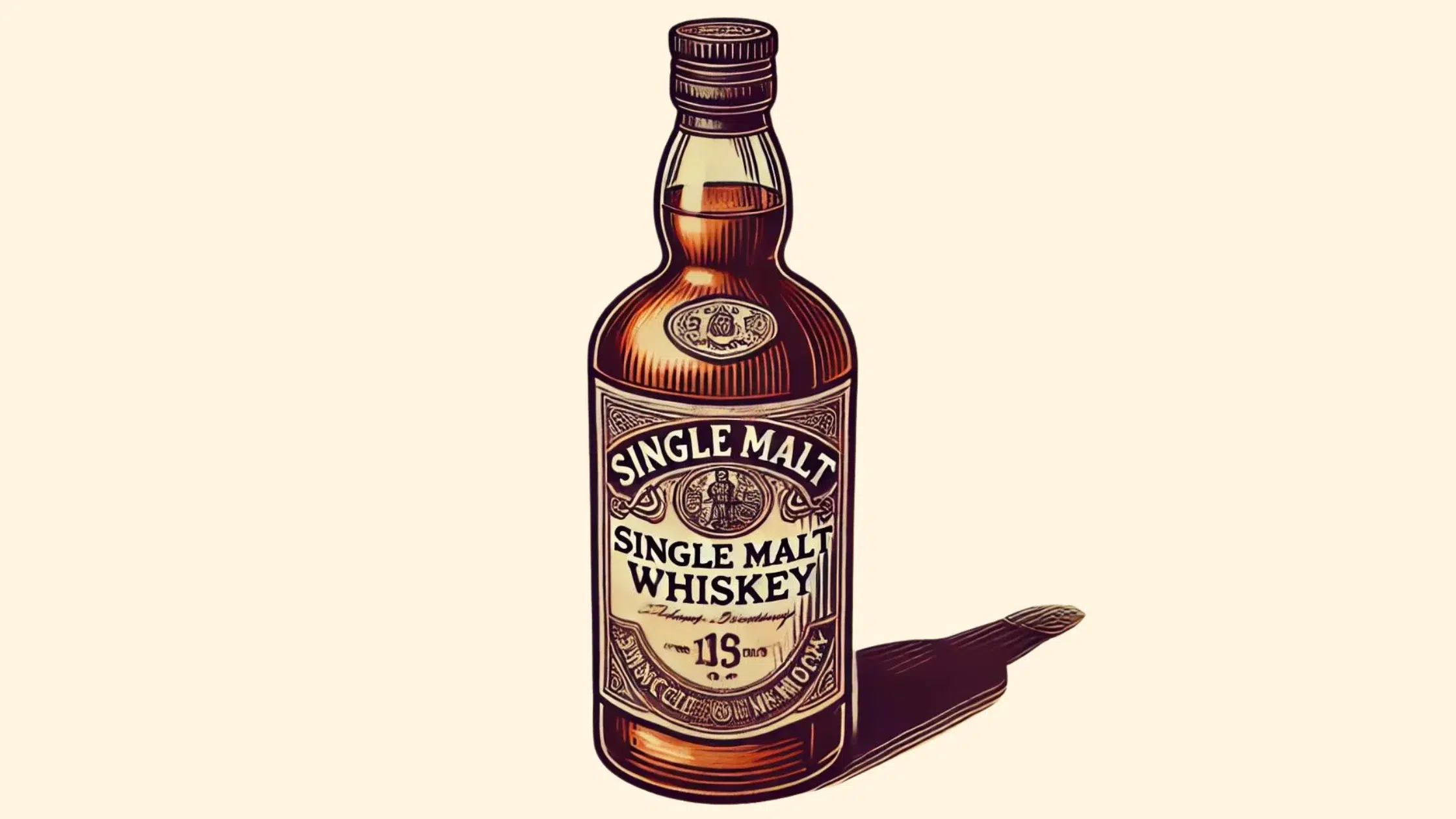If you’ve ever found yourself standing in the whiskey aisle, overwhelmed by the variety and curious about what makes single malt whiskey so special, you’re in the right place. Whether you’re a seasoned enthusiast or just starting your journey into the world of fine spirits, this guide will help demystify the allure of single malt whiskey. We’ll delve into what sets it apart from other types, explore its rich and complex flavors, and offer tips on how to properly enjoy and even start your own collection.
So grab a glass, sit back, and let’s embark on this flavorful adventure together!
What Is Single Malt Whiskey?
Single malt whiskey is a distinct category within the whiskey world, known for its unique production process and rich flavors. It is made from malted barley at a single distillery, ensuring that the whiskey’s character is influenced by the specific techniques and environment of that location. This type of whiskey undergoes a meticulous distillation process in pot stills and is aged in oak barrels, which imparts complex flavors and aromas.
The term “single malt” signifies that the whiskey comes from one distillery, differentiating it from blended malts that combine products from multiple sources. This exclusivity allows single malt whiskey to capture the essence of its origin, offering connoisseurs a taste that reflects the distillery’s heritage and craftsmanship. The aging process, typically lasting several years, enhances the depth and complexity of the final product, making it highly sought after by enthusiasts.
Consumers often seek single malt whiskey for its perceived quality and authenticity. The careful production and aging processes contribute to a premium drinking experience, marked by nuanced flavors and a smooth finish. As a result, single malt whiskey enjoys a reputation for excellence and is a staple in the collections of whiskey aficionados around the world.
Types of Pot Stills and Oak Barrels
To further understand what makes single malt whiskey unique, it’s essential to look at the types of pot stills and oak barrels used in its production. Different stills and barrels can impart distinct characteristics to the whiskey.
| Type | Description | Impact on Flavor |
|---|---|---|
| Copper Pot Stills | Traditional stills used for distillation. Copper helps remove sulfur compounds. | Results in a cleaner, smoother spirit with rich, complex flavors. |
| Wash Still | The first distillation still, larger in size. | Separates alcohol from water and solids, producing a low-alcohol liquid called wash. |
| Spirit Still | The second distillation still, smaller in size. | Refines alcohol, concentrating flavors and increasing alcohol content. |
| American Oak Barrels | Commonly used for aging. Imparts vanilla, caramel, and coconut notes. | Adds sweetness and smoothness to the whiskey. |
| European Oak Barrels | Often used for sherry cask aging. Imparts dried fruit, spice, and nutty notes. | Adds richness and complexity, with a darker color. |
| Japanese Oak Barrels | Rare and unique. Imparts floral and incense-like notes. | Adds a distinct, exotic flavor profile. |
Influence of Distillery Environment
The environment of the distillery also plays a crucial role in shaping the flavor of single malt whiskey. Factors such as climate, water source, and local flora can all influence the final product.
- Climate: Affects the aging process. Warmer climates accelerate aging, while cooler climates slow it down, allowing for more nuanced flavors to develop.
- Water Source: The purity and mineral content of the water used in production can impact the taste. Distilleries often pride themselves on their unique water sources.
- Local Flora: The presence of local plants and trees can influence the air quality and, consequently, the aging process in the barrels.
What Is Single Malt Whiskey?
Single malt whiskey is a distinct category within the whiskey world, known for its unique production process and rich flavors. It is made from malted barley at a single distillery, ensuring that the whiskey’s character is influenced by the specific techniques and environment of that location. This type of whiskey undergoes a meticulous distillation process in pot stills and is aged in oak barrels, which imparts complex flavors and aromas.
The term “single malt” signifies that the whiskey comes from one distillery, differentiating it from blended malts that combine products from multiple sources. This exclusivity allows single malt whiskey to capture the essence of its origin, offering connoisseurs a taste that reflects the distillery’s heritage and craftsmanship. The aging process, typically lasting several years, enhances the depth and complexity of the final product, making it highly sought after by enthusiasts.
Consumers often seek single malt whiskey for its perceived quality and authenticity. The careful production and aging processes contribute to a premium drinking experience, marked by nuanced flavors and a smooth finish. As a result, single malt whiskey enjoys a reputation for excellence and is a staple in the collections of whiskey aficionados around the world.
How Is Single Malt Whiskey Made?
Single malt whiskey is crafted through a meticulous process that involves several key stages. It begins with barley, which is malted to convert its starches into fermentable sugars. This malted barley is then mashed and mixed with water to create a sugary liquid known as wort.
Next comes distillation, where the wort is fermented and then distilled in copper pot stills. This step is crucial as it concentrates the alcohol and refines the flavors. The distilled spirit is then transferred to oak barrels for the aging process.
Aging is where the whiskey develops its complexity and depth. The spirit is left to mature in oak barrels for several years, during which it absorbs flavors from the wood and undergoes chemical changes. This aging process is essential for creating the rich, nuanced flavors that single malt whiskey is known for.
Barley
The journey of single malt whiskey begins with barley, the primary grain used in its production. The barley is malted, a process that involves soaking the grains in water to allow them to germinate. This germination converts the starches in the barley into fermentable sugars.
After germination, the barley is dried in a kiln, sometimes using peat to add a smoky flavor. This malted barley is then ground into a coarse flour called grist, ready for the next stage. To provide more details about the malting process, here is a comprehensive table:
| Stage of Malting | Duration | Conditions | Effects on Flavor |
|---|---|---|---|
| Soaking | 2-3 days | Water immersion | Initiates germination |
| Germination | 4-6 days | Controlled temperature and humidity | Converts starches to sugars |
| Drying | 24-48 hours | Kiln drying, sometimes with peat | Stops germination, adds smoky flavor if peat is used |
Distillation
Distillation is a critical step in making single malt whiskey. The grist is mixed with hot water to extract the sugars, creating a sugary liquid known as wort. The wort is then fermented with yeast to produce a low-alcohol liquid called wash.
This wash is distilled twice in copper pot stills. The first distillation, in the wash still, separates the alcohol from the water and solids. The second distillation, in the spirit still, further refines the alcohol, concentrating the flavors and increasing the alcohol content.
To provide more specifics about the distillation process, here is a detailed table:
| Distillation Stage | Temperature | Still Design | Distillation Cuts | Impact on Flavor |
|---|---|---|---|---|
| First Distillation (Wash Still) | ~173°F (78°C) | Large copper pot still | Heads, Hearts, Tails | Initial separation of alcohol |
| Second Distillation (Spirit Still) | ~173°F (78°C) | Smaller copper pot still | Heads, Hearts, Tails | Refines alcohol, concentrates flavors |
Aging
Aging is where single malt whiskey gains its complexity and depth. The distilled spirit is transferred to oak barrels, where it matures for several years. During this time, the whiskey interacts with the wood, absorbing flavors like vanilla, caramel, and spice.
The aging process also allows for chemical reactions that develop the whiskey’s character. The length of aging can vary, but the result is a rich, nuanced flavor profile that defines single malt whiskey. To enhance the details about the aging process, here is an exhaustive table:
| Type of Oak Barrel | Typical Aging Period | Aging Environment | Impact on Flavor |
|---|---|---|---|
| American Oak | 3-12 years | Varied (e.g., warehouses) | Adds vanilla, caramel notes |
| European Oak | 10-20 years | Varied (e.g., coastal, inland) | Adds spice, dried fruit notes |
| Japanese Oak | 10-20 years | Varied (e.g., humid conditions) | Adds unique floral, incense notes |
What Sets Single Malt Apart?
Single malt whiskey stands out due to its unique production process and distinctive characteristics. Unlike blended whiskey, which combines products from multiple distilleries, single malt is crafted at one distillery using only malted barley. This singular origin allows it to capture the essence of the distillery’s techniques and environment.
The production differences are significant. Single malt undergoes a double distillation process in copper pot stills, which refines the flavors and enhances the alcohol content. The aging process in oak barrels further develops its complexity, allowing for a rich interplay of flavors.
Flavor complexity is another key factor that sets single malt apart. The careful crafting and aging processes result in a whiskey with nuanced flavors and a smooth finish. These characteristics make single malt whiskey highly sought after by enthusiasts and collectors, solidifying its reputation as a premium choice in the whiskey world.
Single Malt vs. Blended
Single malt whiskey differs significantly from blended whiskey. Single malt is produced at one distillery using only malted barley, capturing the unique characteristics of that specific location. In contrast, blended whiskey combines products from multiple distilleries, often using a mix of malt and grain whiskeys.
This blending process aims to create a consistent flavor profile, whereas single malt showcases the distinctiveness of its origin, offering a more authentic experience. Here is a detailed comparison table:
| Aspect | Single Malt Whiskey | Blended Whiskey |
|---|---|---|
| Production | Made at a single distillery using malted barley | Combines products from multiple distilleries, often using a mix of malt and grain whiskeys |
| Distillation | Double distilled in copper pot stills | Often uses continuous column stills for efficiency |
| Flavor Profile | Unique to the distillery, often complex and varied | Aimed at creating a consistent flavor profile |
| Examples | Glenfiddich 12-Year-Old, Macallan 12-Year-Old | Johnnie Walker Black Label, Chivas Regal |
| Authenticity | Captures the essence of its origin | Blended for consistency, less focus on origin |
| Typical Notes | Fruity, smoky, floral, peaty | Smooth, balanced, less complex |
| Aging Process | Aged in oak barrels, often for several years | Can include younger whiskeys for blending |
| Consumer Appeal | Sought after by enthusiasts for its depth and character | Popular for its smoothness and consistency |
Production Differences
The production differences between single malt and blended whiskey are notable. Single malt undergoes a double distillation process in copper pot stills, which helps to refine the alcohol and enhance the flavors. This method is labor-intensive and time-consuming but crucial for developing the whiskey’s complexity.
Blended whiskey, on the other hand, often uses continuous column stills for a more efficient production process, resulting in a different flavor profile that is typically smoother but less complex. Here is a detailed comparison table:
| Production Aspect | Single Malt Whiskey | Blended Whiskey |
|---|---|---|
| Distillation Method | Double distillation in copper pot stills | Continuous column stills |
| Malting Process | Often uses traditional floor malting | Modern malting methods |
| Ingredients | 100% malted barley | Mix of malt and grain whiskeys |
| Aging | Aged in oak barrels, often for several years | Can include younger whiskeys for blending |
| Flavor Development | Complex, influenced by distillery techniques | Blended for a consistent flavor profile |
Flavor Complexity
Flavor complexity is a hallmark of single malt whiskey. The careful crafting and aging processes result in a whiskey with nuanced flavors and a smooth finish. Single malt can offer a wide range of flavor notes, from fruity and floral to smoky and peaty, depending on the distillery’s methods and the aging conditions.
This complexity makes single malt highly sought after by enthusiasts who appreciate its depth and character, providing a rich and varied tasting experience. Here is a detailed table of examples:
| Whiskey | Distillery | Flavor Notes | Aging Process |
|---|---|---|---|
| Glenfiddich 12-Year-Old | Glenfiddich | Fruity, pear, oak | Aged in American oak barrels |
| Macallan 12-Year-Old | Macallan | Rich, sherry, dried fruits | Aged in sherry-seasoned oak casks |
| Laphroaig 10-Year-Old | Laphroaig | Smoky, medicinal, seaweed | Aged in ex-bourbon barrels |
| Yamazaki 12-Year-Old | Yamazaki | Floral, honey, spice | Aged in a mix of American, Spanish, and Japanese oak casks |
Single Malt Flavor Profiles
Single malt whiskey is celebrated for its diverse flavor profiles, which can vary widely depending on the distillery’s techniques and the aging conditions. These flavors are often categorized into distinct groups such as fruity, smoky, and regional variations. Each category offers a unique tasting experience, reflecting the intricate craftsmanship involved in the production process.
Fruity single malts typically feature notes of apple, pear, or citrus, providing a light and refreshing palate. In contrast, smoky single malts, often influenced by the use of peat during the malting process, deliver robust flavors of smoke, earth, and sometimes even medicinal qualities. Regional variations also play a significant role in defining the flavor profiles of single malt whiskeys.
For instance, whiskeys from the Scottish Highlands might exhibit rich, full-bodied flavors, while those from Speyside are known for their elegance and subtle sweetness. This diversity makes single malt whiskey a fascinating subject for enthusiasts who enjoy exploring the wide range of flavors it has to offer.
Fruity
Fruity single malt whiskeys are known for their light and refreshing flavor profiles. These whiskeys often feature notes of apple, pear, and citrus, providing a bright and vibrant tasting experience. The fruity characteristics are typically a result of the distillation process and the type of oak barrels used for aging.
Distilleries in regions like Speyside are particularly known for producing fruity single malts.
| Distillery | Region | Notable Whiskeys | Flavor Notes |
|---|---|---|---|
| Glenfiddich | Speyside | Glenfiddich 12-Year-Old | Apple, pear, oak |
| Balvenie | Speyside | Balvenie DoubleWood 12 | Dried fruit, nutmeg, cinnamon |
| Glenlivet | Speyside | Glenlivet 18-Year-Old | Orange, apricot, toffee |
Smoky
Smoky single malt whiskeys offer a robust and intense flavor profile, often influenced by the use of peat during the malting process. These whiskeys deliver strong notes of smoke, earth, and sometimes medicinal qualities. The smoky flavor is a hallmark of regions like Islay, where peat is abundant and used extensively.
| Distillery | Region | Notable Whiskeys | Flavor Notes |
|---|---|---|---|
| Laphroaig | Islay | Laphroaig 10-Year-Old | Smoke, seaweed, medicinal |
| Ardbeg | Islay | Ardbeg 10-Year-Old | Peat smoke, citrus, vanilla |
| Lagavulin | Islay | Lagavulin 16-Year-Old | Smoke, iodine, dried fruit |
Regional Variations
Regional variations play a crucial role in defining the flavor profiles of single malt whiskeys. For example, whiskeys from the Scottish Highlands are known for their rich, full-bodied flavors, often with a hint of spice. In contrast, Speyside whiskeys are celebrated for their elegance and subtle sweetness, featuring notes of honey and vanilla.
Islay whiskeys are known for their smoky and peaty characteristics, while Lowland whiskeys tend to be lighter and more floral.
| Region | Notable Distilleries | Common Flavor Profiles | Example Whiskeys |
|---|---|---|---|
| Highlands | Glenmorangie, Dalmore | Rich, full-bodied, spicy | Glenmorangie Original, Dalmore 12 |
| Speyside | Macallan, Glenfiddich | Elegant, sweet, fruity | Macallan 12-Year-Old, Glenfiddich 12 |
| Islay | Laphroaig, Ardbeg | Smoky, peaty, medicinal | Laphroaig 10-Year-Old, Ardbeg 10 |
| Lowlands | Auchentoshan, Glenkinchie | Light, floral, grassy | Auchentoshan Three Wood, Glenkinchie 12 |
How to Serve Single Malt Whiskey
Serving single malt whiskey properly can enhance its flavor and aroma, providing a more enjoyable drinking experience. Key factors include selecting the right glassware, maintaining the ideal temperature, and deciding whether to add water or ice. Each of these elements can significantly influence the tasting experience.
The choice of glassware is essential; a tulip-shaped glass is often recommended as it concentrates the aromas, allowing for a more immersive experience. Temperature also plays a crucial role; serving whiskey at room temperature helps to reveal its full flavor profile. Finally, the addition of water or ice can open up the whiskey’s flavors, but it is a matter of personal preference.
Adding a few drops of water can enhance the aromas, while ice can mellow the whiskey and make it more refreshing.
Glassware
Choosing the right glassware is crucial for enhancing the single malt whiskey experience. A tulip-shaped glass is often recommended because it concentrates the aromas, allowing you to fully appreciate the whiskey’s complex scent profile. This type of glass also directs the whiskey to the center of the palate, providing a balanced tasting experience.
Using the proper glassware can significantly elevate the enjoyment of your single malt whiskey.
| Glass Type | Description | Effect on Tasting Experience |
|---|---|---|
| Tulip-shaped | Narrow at the top, wider at the bottom | Concentrates aromas, directs whiskey to the center of the palate for a balanced experience |
| Glencairn glass | Short, sturdy, with a wide bowl and narrow top | Enhances aroma concentration, easy to hold and swirl |
| Tumbler | Wide and flat-bottomed | Suitable for casual drinking, allows for the addition of ice |
| Snifter | Wide bowl with a narrow top, typically used for brandy | Concentrates aromas, allows for gentle warming by hand |
| Copita | Traditional sherry glass with a long stem and narrow top | Ideal for nosing, concentrates aromas |
Temperature
Temperature plays a vital role in serving single malt whiskey. It is generally best to serve the whiskey at room temperature, as this helps to reveal its full range of flavors and aromas. Cold temperatures can mute the intricate notes, while overly warm conditions might intensify the alcohol’s sharpness.
Maintaining the ideal temperature allows you to fully appreciate the whiskey’s complexity and depth.
| Temperature Range | Description | Effect on Tasting Experience |
|---|---|---|
| Room Temperature | Approximately 60-65°F (15-18°C) | Reveals full range of flavors and aromas |
| Slightly Chilled | Approximately 50-59°F (10-15°C) | Mutes some flavors, can be refreshing |
| Cold | Below 50°F (10°C) | Mutes intricate notes, intensifies alcohol sharpness |
| Warm | Above 65°F (18°C) | Can intensify alcohol sharpness, may overpower delicate flavors |
Water or Ice?
Deciding whether to add water or ice to your single malt whiskey is a matter of personal preference, but each option offers unique benefits. Adding a few drops of water can open up the whiskey’s flavors, enhancing its aromas and making it more approachable. On the other hand, ice can mellow the whiskey, making it more refreshing and easier to sip.
Experimenting with both can help you discover how you prefer to enjoy your single malt whiskey.
| Addition | Description | Effect on Tasting Experience |
|---|---|---|
| Water | A few drops to a splash | Opens up flavors, enhances aromas, can make whiskey more approachable |
| Ice | One or more cubes | Mellow the whiskey, makes it more refreshing, can dilute flavors |
| Neat | No additions | Allows for full appreciation of the whiskey’s original flavor profile |
By considering these factors, you can enhance your single malt whiskey tasting experience and discover the nuances that make each bottle unique.
Top Brands
When it comes to single malt whiskey, several top brands stand out for their exceptional quality and distinctive flavors. These brands have earned a reputation for excellence through their meticulous production processes and commitment to craftsmanship. Among the most renowned are Glenfiddich, Macallan, and Yamazaki, each offering a unique expression of single malt whiskey.
Glenfiddich is celebrated for its rich heritage and innovative spirit, producing a wide range of whiskeys that appeal to both novices and seasoned enthusiasts. Macallan is known for its luxurious and complex flavors, often aged in sherry-seasoned oak casks that impart rich, fruity notes. Yamazaki, Japan’s first and oldest malt distillery, brings a distinctively Japanese approach to whiskey-making, resulting in elegant and refined flavors that have gained international acclaim.
These top brands exemplify the diversity and quality of single malt whiskey, making them essential choices for anyone looking to explore this unique category.
Glenfiddich
Glenfiddich is one of the most iconic names in the world of single malt whiskey. Known for its rich heritage and innovative spirit, Glenfiddich produces a wide range of whiskeys that cater to both novices and seasoned enthusiasts. The distillery’s commitment to quality and craftsmanship is evident in its diverse offerings, which include everything from light and fruity expressions to more robust and complex varieties.
Here is a detailed table of notable Glenfiddich expressions and their flavor profiles:
| Expression | Age Statement | Flavor Profile |
|---|---|---|
| Glenfiddich 12-Year-Old | 12 years | Fresh pear, subtle oak, creamy with a long, smooth, and mellow finish |
| Glenfiddich 15-Year-Old | 15 years | Honey, vanilla, rich fruit, and a hint of spice |
| Glenfiddich 18-Year-Old | 18 years | Baked apple, cinnamon, robust oak, and a rich, complex finish |
| Glenfiddich 21-Year-Old | 21 years | Toffee, fig, banana, and a hint of smoke |
| Glenfiddich Experimental Series: IPA Cask | No age statement | Zesty citrus, fresh hops, and a hint of green apple |
| Glenfiddich Experimental Series: Project XX | No age statement | Rich fruit, candy floss, and a hint of licorice |
Glenfiddich’s ability to consistently deliver high-quality whiskey has solidified its reputation as a leader in the industry.
Macallan
Macallan is synonymous with luxury and complexity in the world of single malt whiskey. Renowned for its meticulous production process, Macallan often ages its whiskeys in sherry-seasoned oak casks, which impart rich, fruity notes and a deep, amber color. This attention to detail results in a whiskey that is both luxurious and complex, offering layers of flavor that evolve with each sip.
Here is a detailed table of notable Macallan expressions and their flavor profiles:
| Expression | Age Statement | Cask Type | Flavor Profile |
|---|---|---|---|
| Macallan 12-Year-Old | 12 years | Sherry-seasoned oak | Rich fruit, sherry, vanilla, and a hint of spice |
| Macallan 18-Year-Old | 18 years | Sherry-seasoned oak | Dried fruit, ginger, vanilla, and a hint of clove |
| Macallan Double Cask 12 | 12 years | American and European oak | Honey, citrus, ginger, and a hint of nutmeg |
| Macallan Rare Cask | No age statement | Sherry-seasoned oak | Rich fruit, chocolate, orange, and a hint of raisin |
| Macallan Edition No. 6 | No age statement | Various cask types | Fresh fruit, nutmeg, toffee, and a hint of oak |
| Macallan 25-Year-Old | 25 years | Sherry-seasoned oak | Dried fruit, spice, chocolate, and a long, rich finish |
Macallan’s commitment to excellence makes it a favorite among connoisseurs who appreciate a refined and sophisticated drinking experience.
Yamazaki
Yamazaki holds the distinction of being Japan’s first and oldest malt distillery. Known for its elegant and refined flavors, Yamazaki brings a distinctively Japanese approach to whiskey-making. The distillery’s use of a variety of cask types, including American, Spanish, and Japanese oak, contributes to its unique flavor profile.
Here is a detailed table of notable Yamazaki expressions and their flavor profiles:
| Expression | Age Statement | Cask Type | Flavor Profile |
|---|---|---|---|
| Yamazaki 12-Year-Old | 12 years | American, Spanish, Japanese oak | Peach, pineapple, grapefruit, clove, and a hint of Mizunara oak |
| Yamazaki 18-Year-Old | 18 years | American, Spanish, Japanese oak | Dark chocolate, dried fruit, coffee, and a hint of spice |
| Yamazaki 25-Year-Old | 25 years | American, Spanish, Japanese oak | Rich fruit, spice, Mizunara oak, and a long, complex finish |
| Yamazaki Distiller’s Reserve | No age statement | American, Spanish, Japanese oak | Strawberry, cherry, Mizunara oak, and a hint of coconut |
| Yamazaki Limited Edition | No age statement | Various cask types | Rich fruit, vanilla, spice, and a hint of smoke |
| Yamazaki Sherry Cask | No age statement | Sherry cask | Rich sherry, dark chocolate, dried fruit, and a hint of spice |
Yamazaki’s whiskeys are celebrated for their balance and complexity, often featuring notes of fruit, spice, and a subtle smokiness. This international acclaim has positioned Yamazaki as a must-try brand for anyone interested in exploring the diversity of single malt whiskey.
Starting a Collection
Starting a collection of single malt whiskey can be an exciting and rewarding endeavor. The key is to focus on a mix of beginner picks, rare bottles, and proper storage tips. For beginners, it’s essential to start with accessible and highly-regarded brands that offer a good introduction to the world of single malt whiskey.
As your collection grows, you can seek out rare and limited-edition bottles that add uniqueness and value. Proper storage is crucial to maintaining the quality of your collection. Single malt whiskey should be stored upright in a cool, dark place to prevent the cork from drying out and to preserve the integrity of the whiskey.
Beginner Picks
When starting a single malt whiskey collection, it’s wise to begin with beginner picks that are both accessible and highly regarded. Brands like Glenfiddich 12-Year-Old and Macallan 12-Year-Old offer excellent introductions to the world of single malt. These whiskeys provide a balanced and approachable flavor profile, making them ideal for those new to the category.
Starting with these selections allows you to develop an appreciation for the nuances and complexities that single malt whiskey has to offer. Here are some additional recommendations for accessible and highly-regarded single malts:
| Brand | Expression | Flavor Profile | Why It’s Good for Beginners |
|---|---|---|---|
| Glenfiddich | 12-Year-Old | Light, Fruity, and Floral | Balanced and approachable, easy to enjoy |
| Macallan | 12-Year-Old Sherry Oak | Rich, Fruity, and Spicy | Luxurious and complex, great introduction to sherry cask aging |
| Highland Park | 12-Year-Old | Smoky, Honeyed, and Malty | Offers a gentle introduction to smoky flavors |
| Glenmorangie | Original 10-Year-Old | Citrus, Vanilla, and Almond | Smooth and elegant, very approachable |
| Aberlour | 12-Year-Old | Rich, Chocolatey, and Spicy | Double cask matured, offers complexity and depth |
Rare Bottles
As your collection grows, incorporating rare bottles can add uniqueness and value. Limited-edition releases and older vintages from renowned distilleries like Yamazaki or Macallan are highly sought after by collectors. These rare finds often come with unique flavor profiles and a rich history, making them prized additions to any collection.
Acquiring rare bottles can be a thrilling aspect of collecting, offering both a sense of accomplishment and an opportunity to own a piece of whiskey history. Here are some tips on how to identify and acquire rare bottles:
| Tip | Description |
|---|---|
| Limited Editions | Look for limited-edition releases from well-known distilleries. |
| Older Vintages | Seek out older vintages, which are often more complex and valuable. |
| Auction Houses | Participate in whiskey auctions for rare and collectible bottles. |
| Specialty Retailers | Visit specialty whiskey retailers who may have exclusive or rare offerings. |
| Whiskey Shows and Festivals | Attend whiskey shows and festivals to discover rare bottles and network with other collectors. |
Storage Tips
Proper storage is crucial for maintaining the quality of your single malt whiskey collection. Whiskey should be stored upright to keep the cork from drying out and to prevent oxidation. A cool, dark place is ideal for storage, as fluctuations in temperature and exposure to light can degrade the whiskey over time.
Additionally, keeping the bottles away from strong odors ensures that the whiskey retains its intended flavor profile. By following these storage tips, you can preserve the integrity and value of your collection for years to come. Here are some detailed storage tips:
| Storage Tip | Details |
|---|---|
| Upright Position | Store bottles upright to prevent the cork from drying out and oxidizing. |
| Cool Temperature | Maintain a stable temperature between 15-20°C (59-68°F). |
| Dark Environment | Keep bottles away from direct sunlight to prevent light degradation. |
| Humidity Control | Aim for a humidity level of around 50-70% to protect the cork. |
| Avoid Strong Odors | Store whiskey away from strong odors to prevent flavor contamination. |





